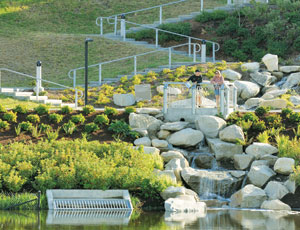The $2-million Sustainable Sites Initiative, having included its four-star rating system within its guidelines for developing and maintaining healthy landscapes, is seeking applications for 75 to 150 pilot projects to test the credit-based program. Applications to SSI, which is taking the first comprehensive look at sustainable landscape design, construction and maintenance, are due by Feb. 15.

On Nov. 5, SSI released the 233-page “SSI: Guidelines and Performance Benchmarks 2009” and “The Case for Sustainable Landscapes,” a set of economic, environmental and social arguments for sustainable land practices. It also launched the two-year pilot-project phase, which will inform an upcoming reference guide.
By 2012, the rating system should be ready for prime time. “I can see a major shift toward wide adoption of SSI within three to five years,” thanks to growing awareness about green building, green regulations and incentive programs, says Nancy C. Somerville, CEO of the American Society of Landscape Architects (ASLA), Washington, D.C., and a member of SSI’s executive committee.
SSI will work as a stand-alone system. But it complements other green-building rating systems, especially the U.S. Green Building Council’s Leadership in Energy and Environmental Design. SSI “picks up where LEED and other [building-centric] systems leave off,” says Somerville.
USGBC and SSI are working on a licensing agreement for reciprocal use of content. “We anticipate incorporating the initiative” into the next version of LEED, says Deon Glaser, USGBC’s manager of LEED technical development. Toward that end, Glaser, a landscape architect, sits on SSI’s steering committee.
The SSI effort, kicked off in 2006, is a partnership of ASLA, the Lady Bird Johnson Wildflower Center and the United States Botanic Garden. Funds come from seven other entities, including $260,000 from the Meadows Foundation and $200,000 from Landscape Structures. The U.S. Environmental Protection Agency also is a supporter.
For the pilots, the group is looking for a range of project types, including transportation projects, in various stages of development and in diverse geographic locations. Any type of designed landscape with or without buildings and exceeding 2,000 sq ft is eligible. “It is critical to road-test the rating system with real-world projects,” says Somerville.
There is no fee to apply. Fees for accepted projects will run between $500 and $5,000, based on a sliding scale of the project’s budget for site grading, landscaping and construction outside the building envelope. The fees will pay for technical assistance from SSI staff. The guidelines and details on the pilot program are available at www.sustainablesites.org.
The guidelines are being developed by 60 professionals, most of whom are volunteers representing myriad disciplines, including scientists, researchers and designers. SSI’s benchmarks and credits are performance-based, not prescriptive. They are not targeted for regional planning, but rather for specific sites. They cover site selection, predesign assessment and planning, site design for water, soil and vegetation, materials selection and issues relating to human health and well-being. The guidelines also cover construction, operations and maintenance. A project landscape architect is not a prerequisite for even the highest rating.
The most historically neglected subject addressed by SSI is hydrology, says Somerville. Inadvertent soil compaction at construction sites, from construction equipment and heavy materials storage, is also addressed. This is a “huge issue,” says Somerville. The compacted site becomes tantamount to an impervious surface, even if it is not paved, and stormwater cannot be filtered, she adds.
ASLA is exploring third-party certification, but no decision has been made to date. An SSI accredited professional program is also under consideration. Though SSI’s focus is on the U.S., mostly because the program references other U.S. green-building programs, there is international interest. “We could absolutely see this or versions of this in other countries in the future,” says Somerville.


Post a comment to this article
Report Abusive Comment